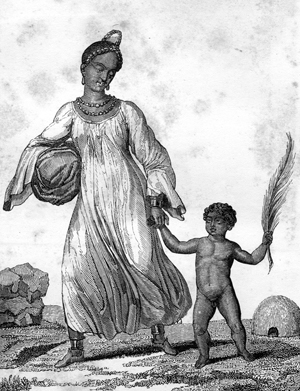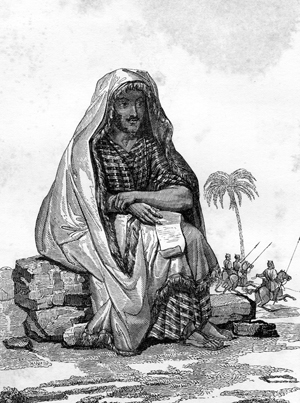“Woman of the City of Timbuctoo”
All the natives inhabitants of Timbuctoo are zealous Mahometans; their dress is similar to that of the Moors. Like the Arabs, they are allowed to have four wives each. The women attend to domestic occupations, and they are not, like the Mandingo females, subject to the punishment of beating. The people of Timbuctoo, who are in constant communication with the half-civilized inhabitants of the Mediterranean, have some idea of the dignity of human nature. I have constantly observed in my travels, that in proportion as a people was uncivilized, the women were always more enslaved. The female sex in Africa have reason to pray for the progress of civilization. The women of Timbuctoo are not veiled like those in Morocco: they are allowed to go out when they please, and are at liberty to see any one. . . . I saw some women who might be considered pretty. They are all well fed: their meals, of which they take two a day, consist of rice, and couscous made of small millet, dressed with meat or dried fish. [Vol. 2, pp. 60-61]
“M. Caillié Meditating Upon the Koran, and Taking His Notes”
During these travels, I always endeavoured to conceal myself while writing, lest I should awaken the suspicion of the Moslems: I always endeavoured to get into a wood, or place myself under the shade of a bush or a rock, when I wished to commit what I thought worthy of remark to writing. When I wrote in the desert, I sat down and placed on my knees some leaves of the Koran, which I was supposed to be copying and studying. [Vol. 2, p. 71]
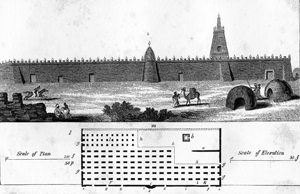
“Sketch of the Plan of the Great Mosque of Timbuctoo, and View Taken from the E.N.E.”
I visited the great mosque on the west side of the town; it is larger than that on the east, but it is built in the same style. The walls are in bad repair, their facing being damaged by the rains, which fall in the months of August and September, and which are always brought on by easterly winds, accompanied by violent storms. Several buttresses are raised against the wall to support them; I ascended the tower, though its staircase, which is internal, is almost demolished. . . . The western quarter of the mosque seems very ancient, but the whole facade on that side is in ruins. There are also some vaulted arcades, from which the whole of the plaster facing is detached. This mosque is constructed of sun-dried bricks, of nearly the same form as those made in Europe. The walls are rough-cast with a kind of coarse sand, similar to that of which the bricks are made, mixed with the gluten of rice. . . . The eastern part is composed of six galleries. . . . The walls of the mosque are fifteen feet high and twenty-five or twenty-six inches thick. [Vol. 2, pp. 71-72]
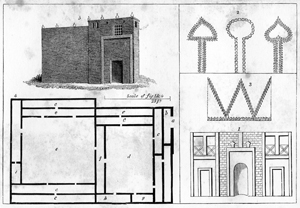
“1, 2, 3: Details of the Great Mosque of Timbuctoo; 4, 5: Plan and Front of the House of Sidi Abdallah Chebir, in Which Mr. Caillié Resided”
On the eastern wall, in the interior of the building, there are some ornaments made of yellow clay. They are in the form of a chevron or triangular festoon, two feet high, with an opening of a foot and a half. They commence about eighteen inches above the ground. The pillars supporting the arcades in the front, have some ornaments of the same material tolerably executed, but bery much defaced. A kind of niche, in the centre of the eastern wall, is destined for the marabout who officiates at prayers. [Vol. 2, pp. 73-74]
Each house forms a square, containing two inner courts, round which are ranged the chambers, each of which is of a narrow oblong form and serves at once for a magazine and bed-room. These rooms receive light only from the door of entrance, and another very small door opening into the inner court. They have neither windows nor chimneys. [Vol. 2, p. 77]
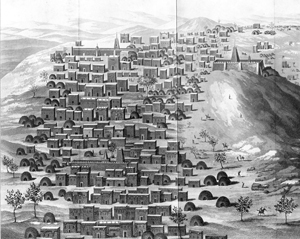
“View of the City of Timbuctoo” [This is the first view of Timbuktu drawn by a European visitor.]
From the tower I had an extensive view over an immense plain of white sand, on which nothing grows except a few stunted shrubs, the mimosa ferruginea, and where the uniformity of the picture is only here and there broken by some scattered hills or banks of sand. I could not help contemplating with astonishment the extraordinary city before me, created solely by the wants of commerce, and destitute of every resource except what its accidental position as a place of exchange affords. . . . In the centre of the town is a kind of square surrounded by circular huts. Here grow some palmœ christi and a palm-tree, the only one I saw in the country. In the middle of this square is a large hole, dug for a receptacle of filth. Two enormous heaps on the outside of the town appeared to me to be also collections of dirt or rubbish. Many a time have I ascended to the tops of these hills to obtain a complete view of the town and to make my sketch. [Vol. 2, pp. 71, 75]
